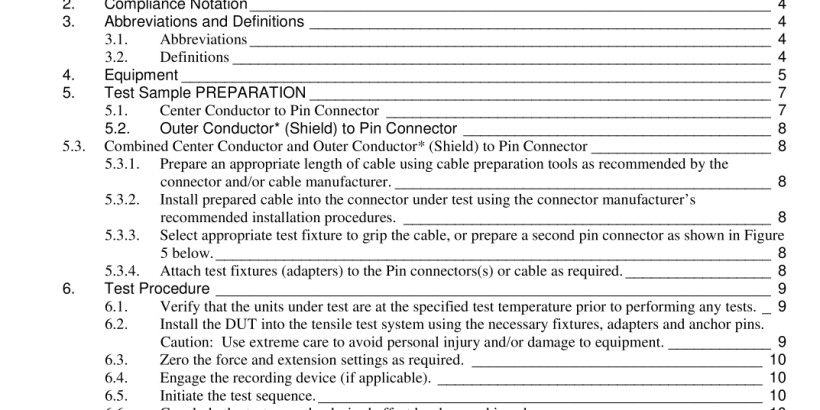ANSI SCTE 102-2016 pdf download.Cable Retention Force Testing of Trunk & Distribution Connectors
1. Scope
1. The purpose of this document is to define a standard test procedure to prepare, test and document the retention forces of a given connector/cable assembly, as whole or separate components.
2. This test is intended to determine the tensile forces required to cause one or more of the following conditions in a connector/cable assembly under test:
• Catastrophic cable structural failure.
• Connector structural failure.
• Separation due to slip at the connector/cable interface.
2. Compliance Notation
This word or the adjective“required” means that the item is an absolute requirement of this specification. This phrase means that the item is an absolute prohibition of this specification. This word means the value specified shall never be used. This word or the adjective“recommended’ means that there may exist valid reasons in particular circumstances to ignore this item, but the full implications should be understood and the case carefully weighted before choosing a different course. This phrase means that there may exist valid reasons in particular circumstances when the listed behavior is acceptable or even useful, but the full implications should be understood and the case carefully weighed before implementing any behavior described with this label. This word or the adjective“optional” means that this item is truly optional. One vendor may choose to include the item because a particular marketplace requires it or because it enhances the product, for example; another vendor may omit the same item. Use is permissible for legacy purposes only. Deprecated features may be removed from future versions of the standard. Implementations should avoid use of deprecated features.
3. Abbreviations and Definitions
3.1. Abbreviations
3.2. Definitions
A mechanical device typically located between the test stand Load Cell or Crosshead and the DUT The material covering the outer conductor (shield) to provide environmental and physical protection. The centermost portion of coaxial cable, typically consisting of solid copper, copper clad aluminum, or other conductive wire. A device for plotting test results such as stress-strain curves. The insulating and support material between the outer surface of the center conductor and the inside surface of the outer conductor (shield). Device under Test, also referred to as specimen or sample.
the maximum stress a DUT is subjected to and will return to its original length once the load is released. A material or substance placed between the outer conductor (shield) and the inside surface of the cable jacket to provide protection to the coaxial cable. A calibrated, sensitive and precision device attached to one end of the test stand that converts tensile or compressive energy into electrical signals for the Chart Recorder or Data Acquisition Unit. the outermost portion of coaxial cable, typically consisting of copper, aluminum, or other conductive material. A device to interface coaxial RF cable to equipment. the point on a stress-strain curve at which the DUT begins to deviate from the straight-line relationship between stress and strain. A computer output port capable of sending actual test data to a remote computer with data acquisition equipment, for processing with data analysis software : A device to interface two pieces of coaxial RF cable. is the amount by which a dimension of a device changes when subjected to a load, divided by the original value of the dimension is force per unit area in pounds per square inch (psi). If stress lengthens or stretches material, it is called tensile stress. The physical device to mechanically perform a tensile/compressive test. Typically incorporates an pin body, center nut and back nut. Typically incorporates an pin body and a back nut.ANSI SCTE 102-2016 pdf download
